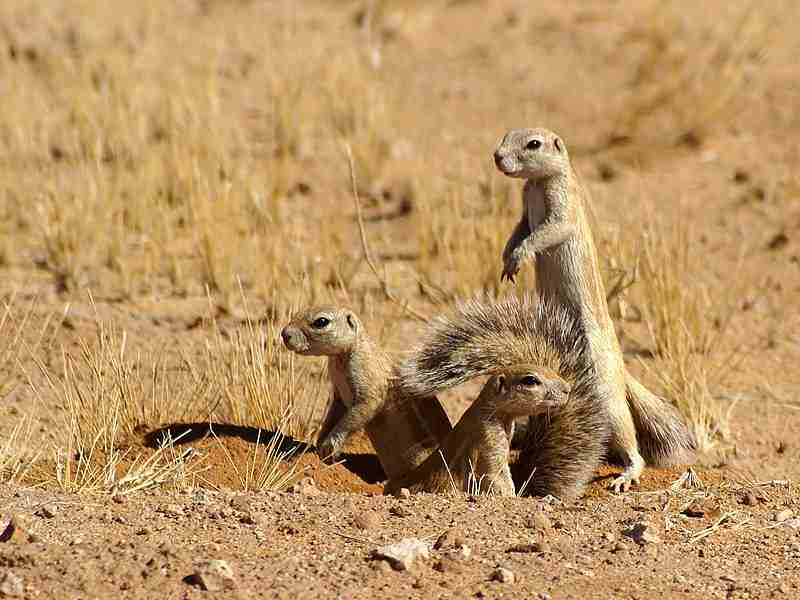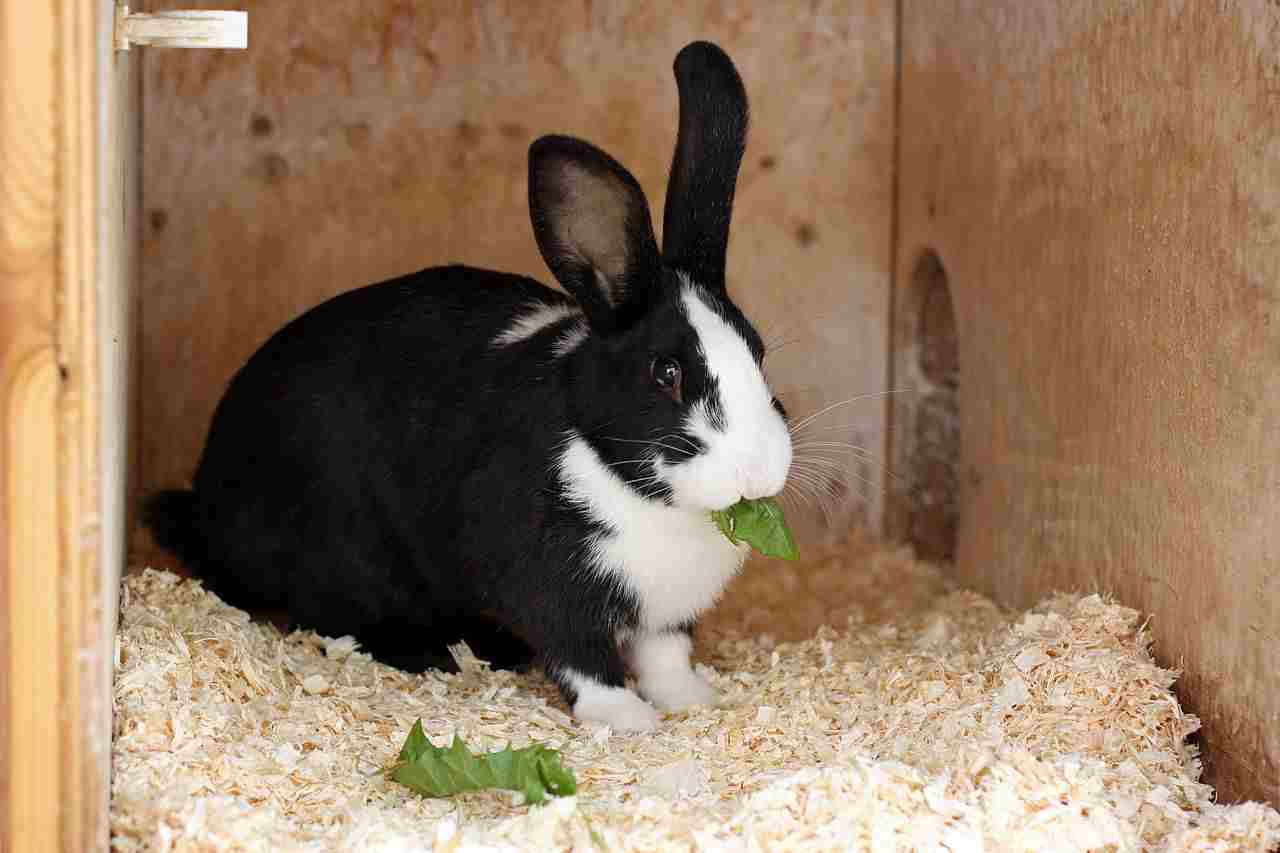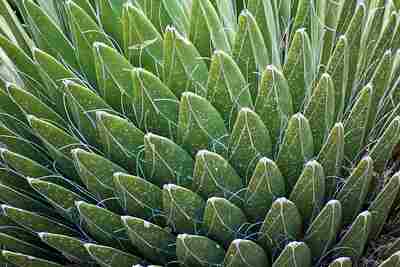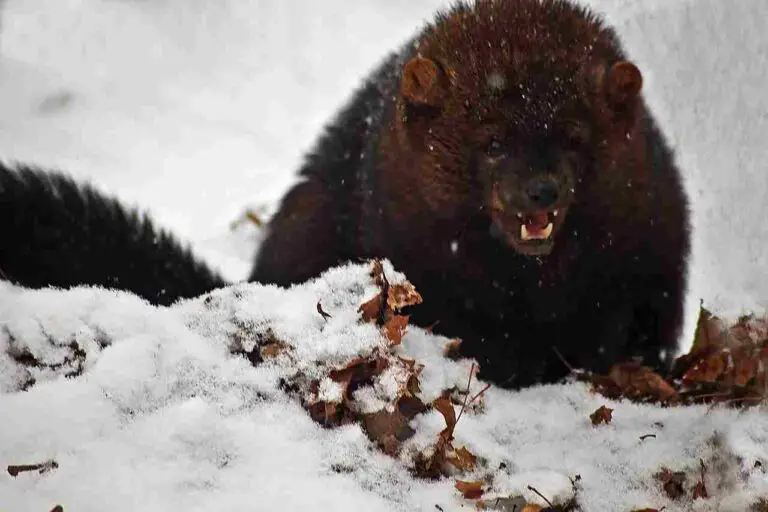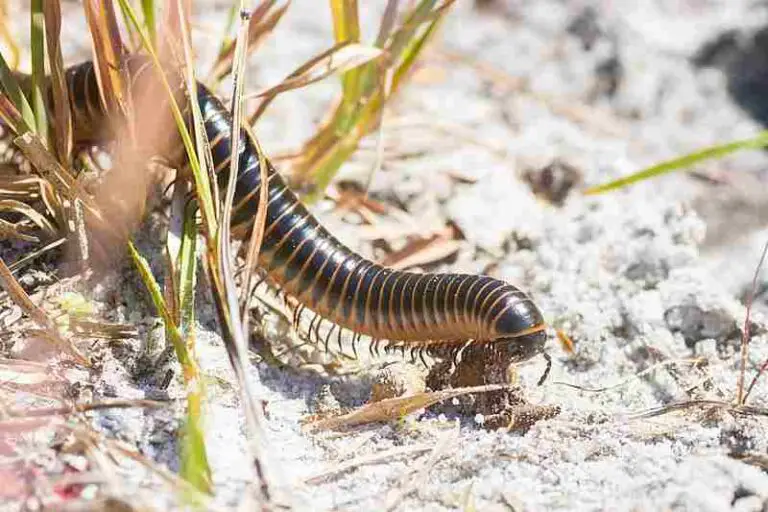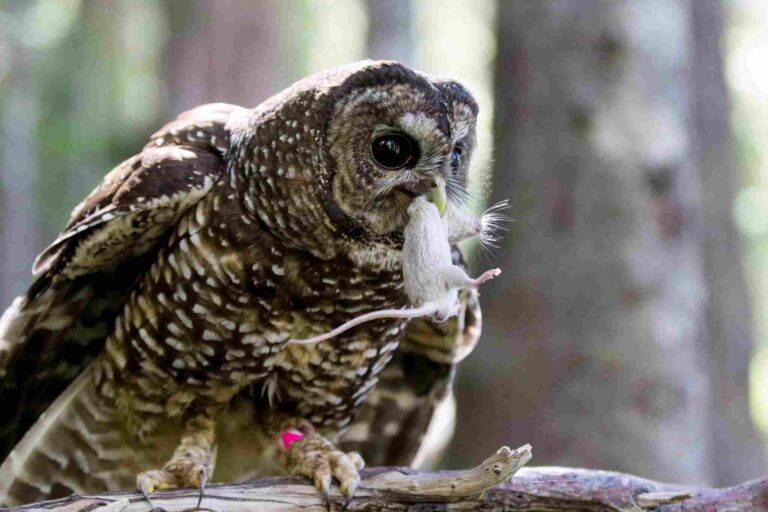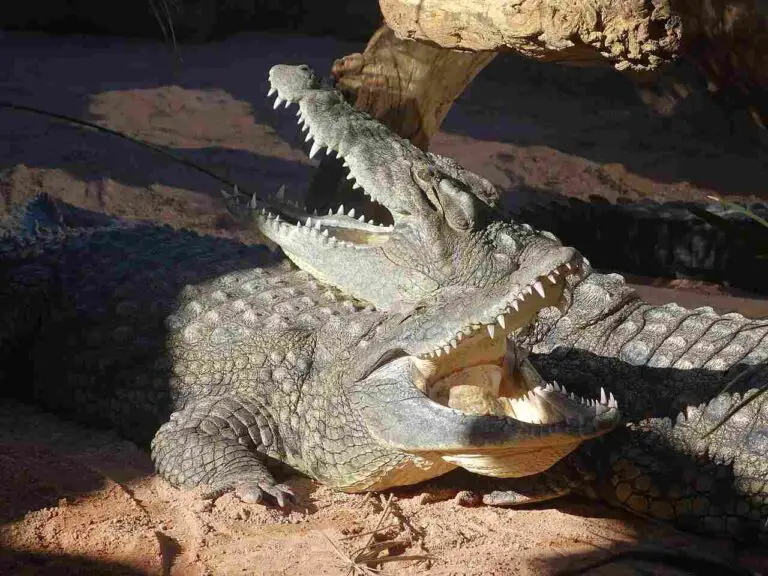9 Adaptations of Animals in the Desert Discussed
Adaptations of animals in the desert are; minimal perspiration, concentrated-urine production, restricted body fat, water-extractive digestion, thermo-regulation, specialized fur, camouflage, burrowing behavior, and large ears for heat-dissipation.
This article discusses adaptations of animals in the desert, as follows;
1). Minimal Perspiration (as one of the Adaptations of Animals in the Desert)
Minimal perspiration is an important adaptation that occurs in several desert animals, and enables them conserve water by the reduction or complete elimination of sweating.
This adaptation enables the animals to tolerate the harsh desert climate, and is often necessary for survival in water scarcity.
Minimizing the rate of water-loss through perspiration prevents dehydration, and allows organisms to maintain their water balance efficiently.
*Examples of Desert Animals with Minimal Perspiration
Desert animals whose adaptations have enabled them minimize perspiration include kangaroo rat and camel.
Kangaroo rat is a small rodent that occurs in arid regions of North America [7].
Their bodies have a low rate of perspiration or sweating, as a result of the absence of prominent water-emitting glands and apertures.
Kangaroo rats also have efficient kidneys that minimize water loss by producing concentrated urine [14]. Moisture in their breath is reabsorbed by specialized nasal passages. These mechanisms and features work together to keep the organism hydrated.

Camel is another desert animal with low rate of perspiration, which aids its survival under severe arid conditions.
Features of camels include thick fur that serves as a heat-barrier, while preventing excessive sweating [2].
They are also able to reduce their body temperature through panting, to conserve water.
*Importance of Minimal Perspiration in Desert Animals
Minimal perspiration is an important adaptive feature in desert animals, because of the limitations of water availability in their environment.
Sweating is a thermoregulatory mechanism in mammals that leads to water loss.
Given the occurrence of high temperatures and the scarcity of water in the desert, excessive sweating is a tendency that must be mitigated to protect animals from dehydration (which could lead to death).
Minimizing perspiration helps desert animals maintain their body's water balance by conserving water, which enables them tolerate the challenging conditions.
*Physiological Adaptations of Desert Animals for Minimal Perspiration
To reduce water loss by perspiration, desert animals have diminished sweat-production structures like glands.
This is supplemented by other conservative features like efficient kidneys for concentrated urine-production, and nasal passages that allow them reabsorb moisture from exhaled gases.
*Behavioral Adaptations of Desert Animals for Minimal Perspiration
Nocturnal activity is a behavior that allows desert animals to minimize perspiration.
This is because the animals are active at nighttime when temperatures are relatively-cool (or cold).
Many desert animals also minimize perspiration by finding shelter in shaded areas like burrows during the day, which reduces the heating effect of solar radiation on their bodies.
*Metabolic Mechanisms for Minimizing Perspiration in Desert Animals
Many desert animals have developed efficient metabolic mechanisms and processes that reduce their rate of water loss.
These include efficient digestion, where the water-content of food materials is maximized alongside nutrients, with minimal waste-production or reliance on external water resources.
2). Concentrated-Urine Production
Concentrated-urine production is an adaptation that can be observed in many desert animals, which is to enable them conserve water in their arid environment [10].
Through the production of highly-concentrated urine with low water content and relatively-high mineral waste, these animals maintain their internal water balance and minimize water loss from their bodies.
Dromedary camel and kangaroo rat are examples of desert animals that produce concentrated urine as a result of evolutionary adaptation.
Kangaroo rats minimize the water content of their urine by means of highly-efficient and specialized kidneys that re-absorb significant amounts of water from urine before it is excreted, through an osmotic mechanism.
The Arabian dromedary camel is capable of surviving for extended periods of time in arid regions, without water. One of the factors behind this animal's tolerance of drought is concentrated-urine production.
Like kangaroo rats, the dromedary camel has a highly-efficient kidney that releases body waste-fluid without losing excessive amounts of water.

*Importance of Concentrated-Urine Production in Desert Animals
The importance of concentrated-urine production in desert animals is based on its role in their survival under conditions of water (and food) scarcity.
Producing and excreting urine with high concentration of waste products and low water-content, help prevent dehydration.
Because waste like urea is still removed from the body, this mechanism ensures that the organism remains healthy and functional without requiring or losing excessive water.
*Mechanism of Concentrated-Urine Production in Desert Animals
Desert animals produce concentrated urine by means of physiological adaptations of the renal system.
Their kidneys posses specialized components that facilitate osmotic water-reabsorption from urine prior to its excretion. The water is assimilated into the bloodstream and retained for sustenance of vital body functions.
This reabsorption mechanism significantly reduces the amount of water that is released along with soluble body waste.
The animal that produces the most concentrated urine is arguably the kangaroo rat, because its kidneys have a high relative medullary thickness that exceeds that of camels [1].
This thickness increases the efficiency with which water in urine is reabsorbed into the bloodstream, to form concentrated urine with low water-to-solute(waste) ratio. It accounts for the kangaroo rat's ability to thrive in harsh arid regions.
3). Restricted Body Fat (as one of the Adaptations of Animals in the Desert)
Restricted body fat is an adaptation that is fairly common in desert animals (which can also be linked to the nature of their diet), and helps them survive the conditions of their habitat.
This is a huge contrast to the physiological adaptation of animals in the tundra and other terrestrial biomes; which often includes a thick layer of fat or blubber for insulation and energy storage.
For desert animals, body fat is present in limited amounts, or entirely absent.
*Why Desert Animals Store Fat in A Restricted Manner
All animals in the desert are challenged by the need to find sufficient food and water in an environment with limited and unpredictable supplies.
The reasons why desert animals store fat in a restricted manner are; in order to conserve water, and to dissipate body heat.
Storing excess body fat is not favorable for desert animals because the metabolism of fats requires (although it also produces) significant amounts of water. Fat can therefore not be used as a medium of energy storage, under arid conditions that demand the conservation of water.
*Examples of Desert Animals with Restricted Body Fat
Camel and fennec fox are two examples of desert animals that have minimal, and restricted, body fat.
In camels, fat storage occurs mainly in their humps [6], while the rest of the body has minimal fat reserves.
Humps therefore serve as energy reservoirs that can be exploited by the animal when food resources are scarce. In spite of this, the total body fat of camels is much lower than that of mammals in temperate regions.
Fennec foxes are small canids inhabiting arid regions. Their physiological features include low/restricted body fat.
While some fat reserves can be found in the bodies of fennec foxes, they have evolved and adapted so that they depend less on fat as a reserve for energy. Rather, these mammals can metabolize proteins and carbohydrates in order to survive periods of food scarcity.
*Importance of Restricted Body Fat in Desert Animals
Restricted body fat in desert animals is a crucial adaptive feature that prevents over-heating of the body.
Because fat layers act as heat-storage media; their presence in any organism (in large proportion) reduces the organism's survival chances in hot environments like the desert.
Also, fat restriction in the bodies of desert animals helps with water conservation.
This is based on the fact that fat requires significant amounts of water for its metabolism or breakdown. Its minimization in animals therefore reduces their water consumption rate, and enables them manage limited resources, which they may allocate for vital body functions.
Other Anatomical Adaptations of Desert Animals
Asides limited fat storage, the anatomical adaptations of desert animals include;
1. Elongated appendages and large ears for heat dissipation
2. Camouflage to minimize heat absorption, elude predators and/or capture prey
3. Specialized fur or hairs for heat protection and insulation against nighttime cold
4. Specialized renal and respiratory structures for water conservation
Most of these adaptations are also discussed in this article.
4). Water-Extractive Digestion Mechanism
Water-extractive digestion is an adaptive mechanism that can be observed in desert animals, and which enables them to extract as much water as possible from food which they consume.
This adaptation is very important for survival of organisms in water-deficient, arid environments.
Efficient extraction and utilization of water contained in food increases the chances of organic survival and brings water loss-rate to the minimum.
*Organisms with Water-Extractive Digestion in the Desert
Desert animals that extract maximum water content from their food include kangaroo rat and desert tortoise.
The kangaroo rats maximize water content of their food in the same re-absorbent manner as they produce concentrated urine.
Their diet includes seeds with minimal moisture content [3], from which they extract as much water as possible through efficient metabolism and digestion, so that they rely less on external sources of water.
Desert tortoises consume vegetation, which may notable amount of moisture. Some species may even consume other materials, like rabbit fecal matter, to extract moisture for metabolic processes [5].
Their rate of metabolism is slow, and allows for maximum extraction of water from their plant diet. Moisture derived by this means is usually enough to reduce their dependence on external sources.

*Importance of Water-Extractive Digestion in Desert Animals
Water extraction during digestion is important for survival of animals in the desert.
Asides water-extractive digestion, other mechanisms and strategies are employed by desert animals to minimize water loss and maximize moisture retention.
Reabsorption of water from urine is a closely-related adaptive (metabolic) function that enables desert animals conserve water resources. Many of these animals also have metabolic processes allowing them to reabsorb water from solid waste before excretion.
Additionally, desert animals may exhibit behavioral traits like nocturnal activity and sheltering, which reduce the loss of water from consumed food materials.
Lastly, desert animals can maximize their water-extraction from food by means of reduced sweat-production, and conservative respiration.
*How Desert Animals Obtain Food and Water
Desert animals are able to survive on limited supply of food resources, as a result of adapting to the conditions of their habitat.
Their food sources range from insects, succulent plants, and mammals, to dry vegetation and seeds. They also store energy from their food in the form of fat, protein and carbohydrate, which are used in times of prolonged scarcity.
Several desert animals are able to effectively survive on water contained in their food.
They may also obtain water from external sources like temporary reservoirs (resulting from rainfall), as well as dew.
Foliage and fruits with high water content are very helpful as sources of water for desert animals.
Water can also be stored by means of specialized adaptive features in some animals, that reduce their reliance on frequent consumption of water-bearing food materials, or water itself.
5). Thermoregulatory Behavior (as one of the Adaptations of Animals in the Desert)
Thermoregulatory behavior is an adaptation in desert animals, which allows them regulate their body temperature under the extreme conditions of their arid environment.
Because of the excessive daytime heat and nighttime cold of deserts [11], it is necessary for animals in this biome to maintain an optimal body temperature in order to sustain their vital metabolic processes for survival.
*Examples of Thermoregulatory Behavior in Desert Animals
Various strategies are employed by desert animals to cope with the temperature conditions of their habitat.
Behaviors that help with thermoregulation in desert animals include; nocturnal activity, shading and basking, burrowing, and postural adjustment.
*Nocturnal Activity as a Thermoregulatory Adaptation in Desert Animals
Many animals in the desert are nocturnal, with most of their activities occurring during the nighttime.
This behavioral adaptation reduces their exposure to the intense daytime heat, and reduces the risk of heat stress and dehydration.
*Shading and Basking
Shading and basking behaviors are common among desert reptiles.
These animals are ectothermic, and rely on such strategies to maintain their body temperature at optimal levels [4].
Shading involves staying in sheltered or shaded arras such as underneath vegetation and rocks, to reduce exposure to heat.
Its effect (which is to cool the body) is opposite to that of basking; which involves exposing the body to solar heat in order to absorb thermal energy and raise the temperature of the body.
Alternating between shading and basking is vital for many desert animals.
*Burrowing as a Thermoregulatory Adaptation in Desert Animals
Burrows help with thermoregulation by providing shelter for desert animals, from extreme heat and cold.
Temperature in the interior of these burrows is usually relatively-stable; due to their isolation from surface conditions and changes.
Kangaroo rats, scorpions and desert tortoises are examples of animals that use burrows to protect themselves from harsh environmental conditions in the desert.

*Postural Adjustment for Thermoregulation in Desert Animals
Adjustment of body posture is practiced by desert animals as a means of controlling their degree of solar exposure.
Examples of this include stretching and coiling, which are practiced by animals like the desert hedgehog and fennec fox.
*Physiological Adaptations of Desert Animals for Thermoregulation
Multiple physiological features have evolved in desert animals, for coping with high temperatures.
An example of these is the dark coloration of reptilian scales, which allow them to rapidly absorb high amounts of solar radiation while basking.
Specialized blood vessels that occur near the skin surface in many desert animals (again including reptiles) also facilitate rapid heat exchange, which helps with cooling.
*Examples of Desert Animals with Thermoregulatory Behavior
Examples of desert animals that exhibit thermoregulatory behaviors include, dung beetle, fennec fox, sidewinder rattlesnake, and desert tortoise.
Dung beetle regulates its temperature by rolling balls of animal waste and using these as thermal shields in its microhabitat [13].
Fennec fox avoids daytime heat by engaging in more activity at night when temperatures are cooler.
Sidewinder rattlesnake thermoregulates by moving in a sidewinding manner that exposes minimal body surface area to the hot sand.
Similarly, the desert tortoise regulates its body temperature by seeking shade and minimizing its exposed body-surface area.
6). Specialized Fur for Heat Protection and Nighttime Insulation
Specialized fur is one of the adaptations of desert animals, used to lessen the impact of their harsh environment.
These animals use their specialized fur for protection from extreme daytime heat, as well as for insulation from nighttime cold.
There are various fur characteristics that have developed in desert animals to enable them thrive in their habitat. These include low fur-density, light coloration, and thermal-insulating fur.
*Low Fur Density in Desert Animals
Some desert animals can be described as having thin or sparse fur. Examples of these animals are jerboa and kangaroos rat.
The jerboa stays cool in its hot arid habitat by means of its thin coat of fur. Similarly, kangaroo rats have sparse, short fur that allows for effective dissipation of heat, and minimizes heat retention.

*Light Fur Coloration in Desert Animals
Several desert animals have light-colored fur that is useful for reducing heat absorption and reflecting solar infrared radiation.
Light biege is an example of s reflective fur color found in desert animals like the desert hare and fennec fox.
In desert hares, light-colored fur is very helpful for their crepuscular lifestyle, because it enables them stay cool by reflecting much of the solar radiation that falls upon them during the day.
Fennec foxes also have a sandy-colored, pale coat that both enables them blend into the landscape and reflects solar radiation to prevent overheating.
*Thermal Insulation as an Adaptive Function of Desert Animal Fur
In addition to the need for protection from extreme heat during the day, desert animals require nighttime protection from cold.
The fur of desert animals often provides this protection in the form of thermal insulation, which helps then to retain body heat during cooler periods.
Some examples of desert animals that have insulating fur are; desert hedgehog and kit fox.
Desert hedgehogs have a fur layer (along with their spines) which provide insulation, in the same manner as the fur of kit foxes.
Because fur is non-conductive, it causes a layer insulating air to form around the body of desert animals, which prevents rapid loss of heat to the environment at night. It must be noted that this fur is usually also thin enough to prevent excessive accumulation of heat during the day.
In summary, the functions of fur in desert animals are;
1. Heat dissipation
2. Heat reflection
3. Insulation
7). Camouflage (as one of the Adaptations of Animals in the Desert)
Camouflage is another adaptation that occurs in many desert animals, which enables them to seamlessly blend into the sandy landscape.
In these animals, camouflage is helpful for eluding predators, as well as for concealment when stalking prey.
Various strategies have been developed by desert animals in the course of their evolution, that help them to match the texture and color of their environment. As a result, many of these animals can move across the landscape and remain virtually unnoticeable.
*Desert Animals with Camouflage as A Major Adaptation
Examples of desert animals that posses effective camouflage are; Saharan silver ant, desert horned lizard, and desert sand viper.
Saharan silver ant is an arthropod that occurs in hot deserts in Africa [12].
It has a distinctive silver coloration that provides camouflage and makes it hard to distinguish from desert sand. The same coloration helps to reflect solar radiation and prevent overheating.

Desert horned lizard has a rough body surface whose coloration is similar to that of rocks and sand. It has the tendency to lay flat and still when threatened, so that it becomes almost impossible to distinguish from its surrounding. This protects the lizard from raptors as well as reptilian and mammalian predators.
Desert sand viper is a venomous snake whose physiological adaptation allows it to blend seamlessly into the desert landscape.
It uses this concealment to stalk and ambush prey, which include lizards and rodents; while eluding potential predators.
*Importance of Camouflage in Desert Animals
The importance of camouflage in desert animals includes;
1. Prey ambush and capture
2. Avoidance of predators
3. Thermoregulation
8). Burrowing Behavior
Many animals in the desert exhibit burrowing behavior as part of their adaptive strategy for survival.
Burrowing involves digging tunnels into the ground to serve as shelter and protective structures from the extreme heat and cold, as well as the intense dryness of the external environment.
*Burrowing Animals in the Desert
Examples of desert animals with burrowing behavior are; desert beetle, jerboa, desert tortoise; and fennec fox.
Various desert beetle species, including tenebrionid beetles, are burrowers [9].
These insects dig shallow tunnels in the loose desert sand in which they shelter from the extreme surface heat. Such burrows provide cooler and more humid conditions that the more humid external environment.
Jerboas are small rodents with hopping-locomotion patterns, that are found in deserts.
These rodents dig burrows in the sand, which provide shelter from intense daytime heat, and protection from predators.
Burrows enable the jerboa to conserve water and stay cool, by providing a relatively-mild microclimate.
Desert tortoise is a reptile that inhabits arid areas in North America [8].
Most of its time is spent sheltering in burrows in the rocky; sandy terrain.
These burrows protect the tortoise from predators and extreme environment conditions, while helping with thermoregulation and moisture conservation.

Fennec foxes occur in the Sahara Desert, where they exhibit excellent burrowing abilities, and are known to construct complex tunnel-dens underground.
Burrows are used to raise the fox's young, and provides protection from extreme climatic conditions.
*Reasons Why Desert Animals Burrow
Reasons why desert animals burrow are;
1. For protection from predators
2. Temperature regulation
3. For conservation of water
4. For nesting and raising their young
9). Large Ears for Heat-Dissipation (as one of the Adaptations of Animals in the Desert)
Large ears are a fairly-common adaptation that occurs in several desert animals.
They play an important role in thermoregulation and heat dissipation.
Desert animals with large ears are the result of multiple generations of adaptive evolution in an environment characterized by intense heat.
*Examples of Desert Animals with Large Ears
Examples of desert animals that possess large ears are; big-eared kangaroo rat, fennec fox, and African elephant.
Big-eared kangaroo rat (Dipodomys elephantinus) is a specie of kangaroo rat that inhabits arid areas and chaparrals (shrublands) in North America. It is distinguished by its ears; which are relatively large.
Fennec fox in the Sahara desert is also distinguished by its exceptionally-large ears, which can grow up to 6 inches in length.
Dye to their large surface area, fennec fox ears are very effective for dissipation of excess body heat, which helps with thermoregulation.
Most of this heat is released from the bloodstream through vessels that occur near the surface of the ears.

While it is more commonly found in the savanna grassland, the African elephant's geographic range covers many semiarid zones, and may eve occur in marginal zones of the Sahara
Here, its large ears (which can be as broad as six feet) are equipped with shallow-seated blood vessels, and aid with heat dissipation. Flapping their ears also increases air circulation around the blood vessels, and increases the efficiency of heat loss.
*Functions of Large Ears in Desert Animals
Functions of large ears in desert animals are;
1. Thermoregulation
2. Heat dissipation
3. Survival in arid environments
Conclusion
Adaptations of animals in the desert are;
1. Minimal Perspiration
2. Concentrated-Urine Production
3. Restricted Body Fat
4. Water-Extractive Digestion Mechanism
5. Thermo-regulatory Behavior
6. Specialized Fur for Heat Protection and Nighttime Insulation
7. Camouflage
8. Burrowing Behavior
9. Large Ears for Heat-Dissipation
References
1). Abdalla, M. A. (2020). "Anatomical features in the kidney involved in water conservation through urine concentration in dromedaries (Camelus dromedarius)." Heliyon. 2020 Jan 2;6(1):e03139. Available at: https://doi.org/10.1016/j.heliyon.2019.e03139. (Accessed 28 June 2023).
2). Abdoun, K. A.; Samara, E. M.; Okab, A.B.; Al-Haidary, A. A. (2012). "Regional and circadian variations of sweating rate and body surface temperature in camels (Camelus dromedarius)." Anim Sci J. 2012 Jul;83(7):556-61. Available at: https://doi.org/10.1111/j.1740-0929.2011.00993.x. (Accessed 28 June 2023).
3). Frank, C. L. (1988). "The Influence of Moisture Content on Seed Selection by Kangaroo Rats." Journal of Mammalogy 69(2):353-357. Available at: https://doi.org/10.2307/1381385. (Accessed 29 June 2023).
4). Hertz, R. B.; Huey, R. B.; Stevenson, R. (1999). "Temperature regulation in free-ranging ectotherms: what are the appropriate questions?" African Journal of Herpetology 48(1-2):41-48. Available at: https://doi.org/10.1080/21564574.1999.9651070. (Accessed 29 June 2023).
5). Joshua, Q. I.; Hofmeyr, M.; Henen, B. (2010). "Seasonal and Site Variation in Angulate Tortoise Diet and Activity." Journal of herpetology 44(Mar 2010):124-134. Available at: https://doi.org/10.1670/08-306R1.1. (Accessed 29 June 2023).
6). Li, Q.; Yang, L.; Li, R.; Chen, G.; Dong, J.; Wu, L.; Fu, Y.; Yang, J. (2023). "Lipid analysis of meat from Bactrian camel (Camelus bacterianus), beef, and tails of fat-tailed sheep using UPLC-Q-TOF/MS based lipidomics." Front Nutr. 2023 Mar 2;10:1053116. Available at: https://doi.org/10.3389/fnut.2023.1053116. (Accessed 29 June 2023).
7). Lima, M.; Ernest, S. K.; Brown, J. H.; Belgrano, A.; Stenseth, N. C. (2008). "Desert kangaroo rats: nonlinear effects of population dynamics, competition, and rainfall." Ecology. 2008 Sep;89(9):2594-603. Available at: https://doi.org/10.1890/07-1246.1. (Accessed 28 June 2023).
8). Nussear, K. E.; Esque, T. C.; Inman, R.; Gass, L.; Thomas, K. A.; Wallace, C. S. A.; Blainey, J. B.; Miller, D. M.; Webb, R. H. (2009). "Modeling habitat of desert tortoise (Gopherus agassizii) in the Mojave and parts of the Sonoran deserts, California, Nevada, Utah, and Arizona." Available at: https://pubs.er.usgs.gov/publication/ofr20091102. (Accessed 29 June 2023).
9). Raś, M.; Kamiński, M. J.; Iwan, D. (2022). "Fossoriality in desert-adapted tenebrionid (Coleoptera) larvae." Springer Nature, Scientific Reports 12(1):13233. Available at: https://doi.org/10.1038/s41598-022-17581-6. (Accessed 29 June 2023).
10). Rocha, J. L.; Brito, J. C.; Nielsen, R.; Godinho, R. (2021). "Convergent evolution of increased urine-concentrating ability in desert mammals." Mammal Review 51(4). Available at: https://doi.org/10.1111/mam.12244. (Accessed 29 June 2023).
11). Schwimmer, H.; Haim, A. (2009). "Physiological adaptations of small mammals to desert ecosystems." Integr Zool. 2009 Dec;4(4):357-66. Available at: https://doi.org/10.1111/j.1749-4877.2009.00176.x. (Accessed 29 June 2023).
12). Shi, N. N.; Tsai, C. C.; Camino, F.; Bernard, G. D., Yu, N.; Wehner, R. (2015). "Thermal physiology. Keeping cool: Enhanced optical reflection and radiative heat dissipation in Saharan silver ants." Science. 2015 Jul 17;349(6245):298-301. Available at: https://doi.org/10.1126/science.aab3564. (Accessed 29 June 2023).
13). Smolka, J.; Baird, E.; Byrne, M. J.; el Jundi, B.; Warrant, E. J.; Dacke, M. (2012). "Dung beetles use their dung ball as a mobile thermal refuge." Curr Biol. 2012 Oct 23;22(20):R863-4. Available at: https://doi.org/10.1016/j.cub.2012.08.057. (Accessed 28 June 2023).
14). Urity, V. B.; Issaian, T.; Braun, E. J.; Dantzler, W. H.; Pannabecker, T. L. (2012). "Architecture of kangaroo rat inner medulla: segmentation of descending thin limb of Henle's loop." Am J Physiol Regul Integr Comp Physiol. 2012 Mar 15;302(6):R720-6. Available at: https://doi.org/10.1152/ajpregu.00549.2011. (Accessed 29 June 2023).
